
KTS Diagnostics Made ‘ESI’ from Robert Bosch
This regular series of technical articles from Bosch focuses on how to get the best out of its ESI[tronic] 2.0 software, which is used in conjunction with the KTS range of diagnostic tools for vehicle fault diagnosis and service function procedures.
In this latest instalment we’ll be looking at the vast amounts of vehicle service information and maintenance data that is available in Bosch ESI 2.0.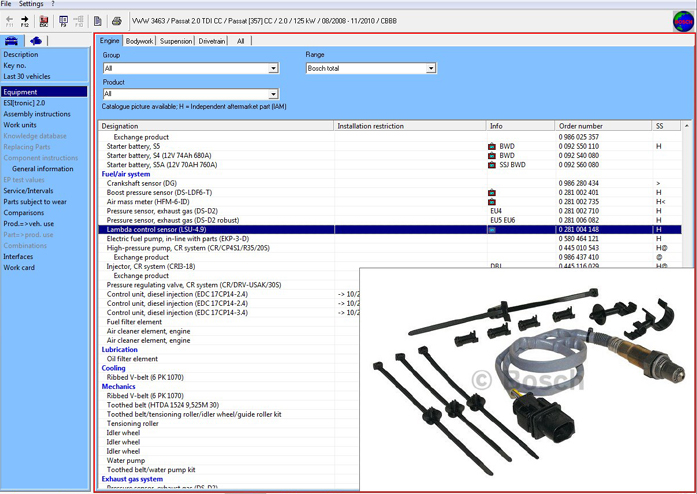
If you subscribe to the A, SD, SIS, M, P & TSB complete technical package, this software is often referred to as the ‘Master Package’. The in-depth data, detailed descriptions and diagrams, plus other essential information, demonstrates that the Bosch KTS with ESI 2.0 software is so much more than a regular diagnostic ‘scan tool’.
Once you’ve selected a vehicle in the ESI[tronic] 2.0 program, you can then choose the ‘Maintenance’ tab at the top of the screen. Now you will see a row of sub tabs with the many different information sources related to the vehicle’s service and maintenance requirements. In fact, there are so many tabs to fit on the screen all at once, the ‘show next/previous’ arrow soft keys need to be used to scroll across the various available chapters (see below).

Service schedules
Depending on the vehicle make and model that you’ve chosen, you now need to select the type of ‘service’ required. Often at this stage a handy ‘pop up’ message appears with important timing belt replacement interval data. ESI[tronic] lists the services, including mileage and month intervals, and also provides job times in hours for the service type and additional items (see below).
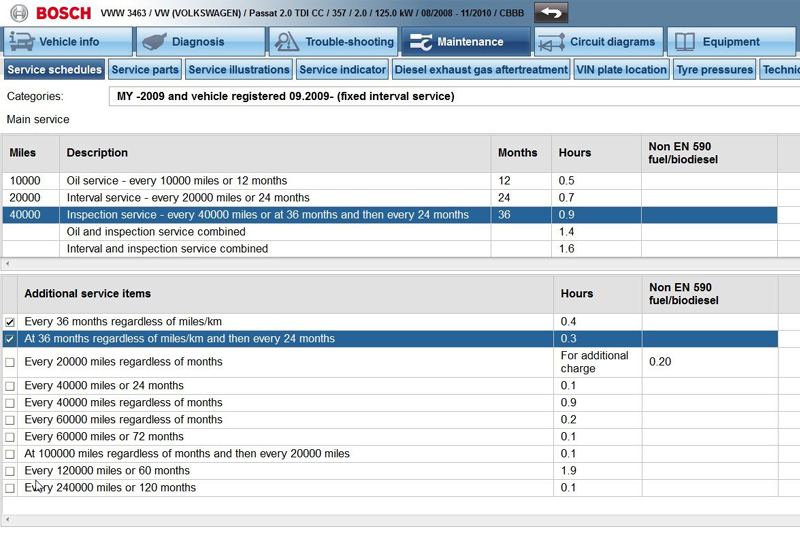
By clicking on the ‘Display operations’ soft key in the bottom right hand corner, you can create a specific service check sheet and display it on screen. The check sheet can be printed out and completed manually or electronically throughout the job and printed at the end. This is a nice feature to prevent any greasy fingerprints spoiling the list (see below).
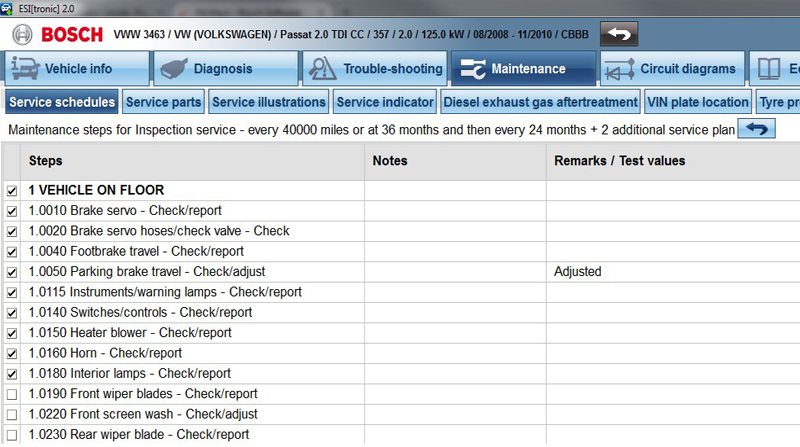
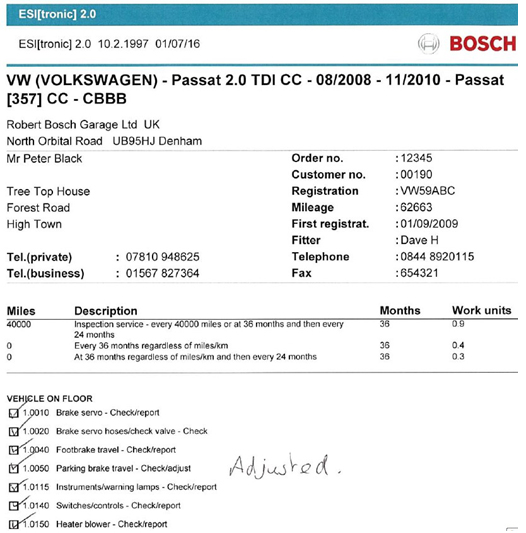
Once you’ve selected the required service operations, this activates the ‘Service parts’ tab. This section will list out the necessary spare parts, such as oil and filters, along with capacities that will be needed to complete the service work on the vehicle.
The next tab – ‘Service illustrations’ – provides all the available diagrams to aid you whilst servicing the vehicle, such as transmission oil level plugs, auxiliary drive belt routing, cabin filter location and A/C
service port locations (see below).
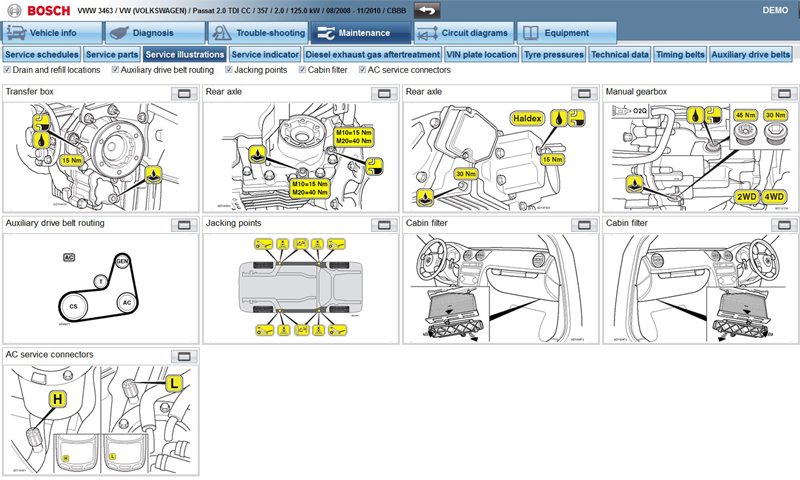
You can expand each individual diagram to full screen, if needed, so that you can view it in more detail and this is really helpful on today’s complex vehicles.
The ‘Service indicator’ tab guides you through the service light reset process for the vehicle you’re working on (see below).
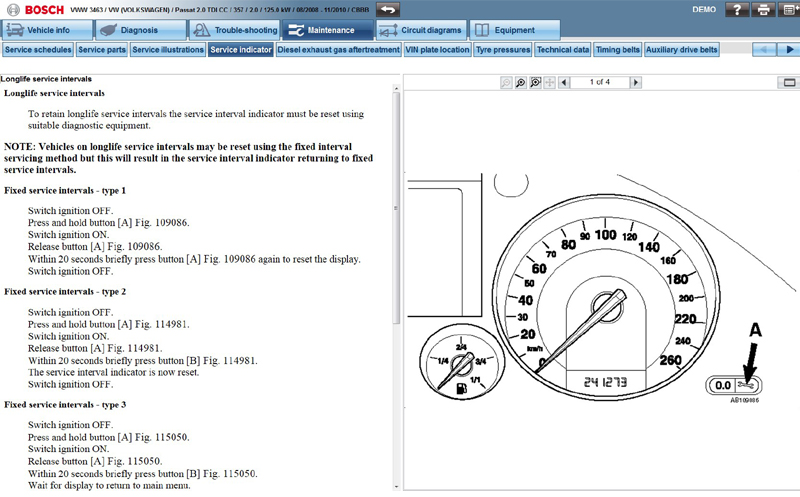
This may involve a ‘manual’ push button reset as described or a diagnostic reset routine where the instructions will contain a hyperlink to take you straight to the correct area within the ‘Diagnosis’ main tab to perform the task. On diesel vehicles the ‘Diesel exhaust gas after treatment’ tab will be active and demonstrates how the DPF system works and how to initiate a passive Diesel Particulate Filter Regeneration. DPF problems on vehicles are increasingly common due to short journeys so this is a particularly useful section of data on the tool.
The ‘VIN plate location’ tab offers a vehicle specific diagram of where to find identification details, such as VIN and engine numbers, as well as the exact position of the bonnet release safety catch, which can be tricky to find on some models (see below).
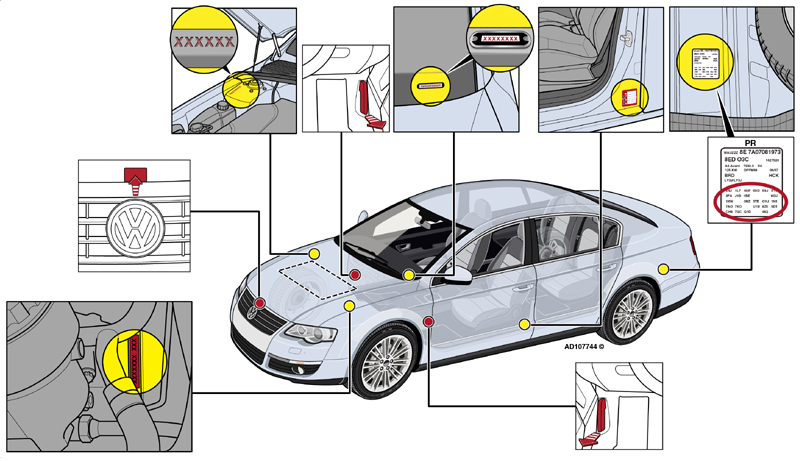
The ‘Tyre pressures’ tab lists all of the recommended tyre pressures for the vehicle model selected. In some cases this can be quite a long list due to fitment variations but the search bar can be used to narrow down the options by wheel size or tyre width. The manufacturer specified front and rear tyre pressures are also given in bar and psi for ‘laden’ and ‘un-laden’ situations.
The ‘Technical data’ tab is highly useful as it supplies essential information about all of the following: vehicle designation; fuel injection system; tuning & emissions; starting & charging systems; service checks & adjustments; fluid types & capacities; tightening torque settings; minimum brake component thicknesses and air conditioning system service & repair data. Wherever possible, the list will have icons that will present you with ‘pop up’ important information and diagrams that can help you do the job properly and efficiently (see below).
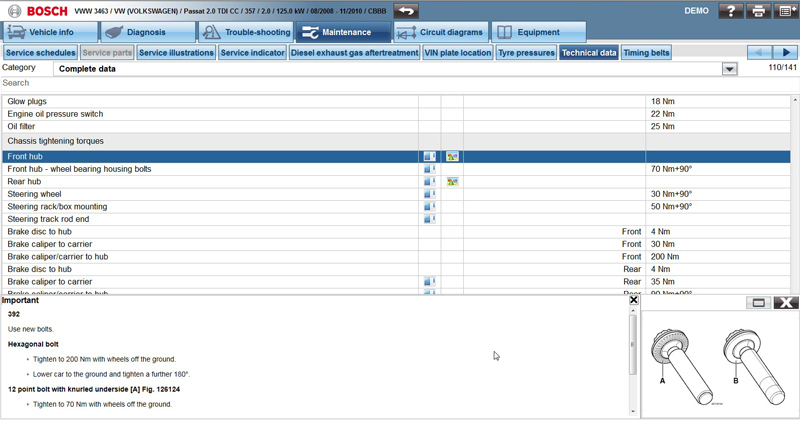
In the ‘Timing belts/chains’ tab you’ll find detailed instructions and diagrams for changing the belt, chain or timing gears when they’re due for replacement or in the event of an engine re-build. With such a complex task, it’s critical to have the correct information to complete the job properly and this section will give you piece of mind that the manufacturer’s procedure has been followed (see below).
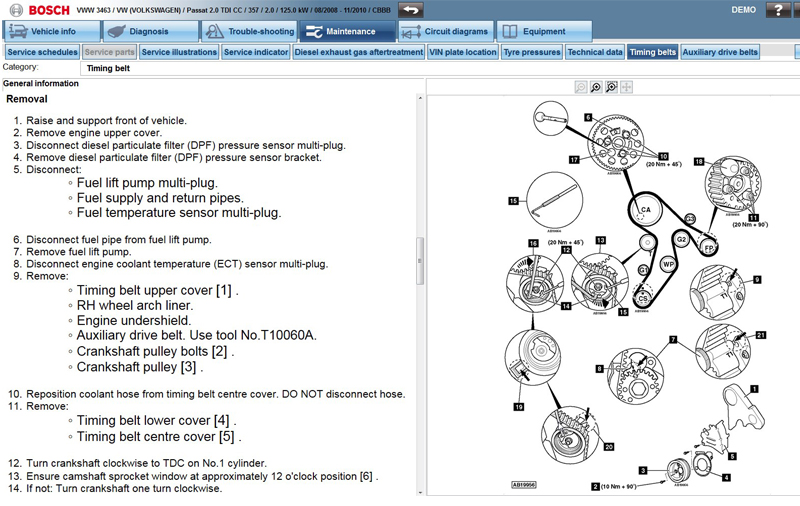
The ‘Auxiliary drive belts’ tab guides you through the auxiliary drive belt and belt tensioner system operation. You’ll find all the details, text and diagrams showing the removal and installation procedure of the system components, as well as tightening torques of the mounting bolts.
In the ‘Wheel alignment’ section, the recommended suspension geometry measurement values and setting data is displayed. The tolerances and diagrams for the toe-in, camber and caster adjustments to the front and rear wheels of the vehicle (where applicable) are used with suitable wheel alignment measuring equipment to correctly align the wheels on the car.
‘Key programming’ allows you to access all the information, with reference to key battery replacement and remote central locking synchronisation (see below).

With many cars having ‘keyless’ entry and start systems, the instructions and diagrams in this section can be a real assistance if any key problems are experienced with a customer’s car.
Now we’ve covered all of the ‘Maintenance’ section sub-tabs, please remember that you can click the ‘Print’ icon, next to the ‘Main menu’ soft key in the top right hand corner of the screen. You can also produce a screen shot of the data or print out the diagrams and text for reference.
The last main tab is the ‘Equipment’ tab. This opens up a new window on your screen and is the original ESI[tronic] parts list, which in Bosch we refer to as the ‘A’ content disc. The parts list contains all available information on every component made by Bosch for the vehicle (RB key) that you’ve selected. This includes descriptions, model year ranges, diagrams, pictures and Bosch part numbers for the components.
The Bosch parts are grouped in the categories of Engine, Bodywork, Suspension and Drivetrain. Depending on the vehicle manufacturer, the parts made by Bosch on the vehicle can range from batteries, alternators, starter motors and engine management sensors to wipers, lighting products, filters, brake components and fuel system pumps or injectors (see below).

It’s often quite amazing to see just how many OE quality parts are made by Bosch that are available on
many cars today.









